Cocaine Self-Administration and Abstinence Modulate NMDA Receptor Subunits and Active Zone Proteins in the Rat Nucleus Accumbens
Abstract
:1. Introduction
2. Results
2.1. Behavioral Effects
2.1.1. Cocaine Self-Administration
2.1.2. Cocaine Abstinence in an Enriched Environment
2.1.3. Cocaine Abstinence in an Isolated Condition
2.1.4. Cocaine Abstinence with Extinction Training
2.1.5. Cocaine Abstinence without the Instrumental Task
2.2. Expression of NMDA Receptor Subunits
2.2.1. Cocaine Self-Administration
2.2.2. Cocaine Forced Abstinence
2.3. Proteins Involved in Synaptic Vesicle Exocytosis
2.3.1. Cocaine Self-Administration
2.3.2. Cocaine Forced Abstinence
3. Discussion
4. Materials and Methods
4.1. Animals
4.2. Drugs
4.3. Intravenous Catheter Implantation
4.4. Initial Training to Lever Presses
4.5. Cocaine Self-Administration
4.6. ‘Yoked’ Procedures
4.7. Cocaine Abstinence Procedures
4.7.1. Cocaine Abstinence in an Enriched Environment
4.7.2. Cocaine Abstinence in an Isolated Condition
4.7.3. Cocaine Abstinence with Extinction Training
4.7.4. Cocaine Abstinence without the Instrumental Task
4.8. Dissection
4.9. Biochemical Analyses
4.9.1. NMDA Receptor Subunits Analyses—Western Blot
4.9.2. RIM1, Munc13 and Rab3A Analyses—ELISA
4.10. Statistical Analyses
Supplementary Materials
Author Contributions
Funding
Conflicts of Interest
Abbreviations
| Cav1.3 | voltage-gated calcium channels, L type, alpha 1D subunit |
| FR | fixed ratio |
| LTD | long-term depression |
| LTP | long-term potentiation |
| Munc13 | mammalian uncoordinated protein 13 |
| NMDA | N-methyl-d-aspartate |
| Rab3A | Ras-related protein 3A |
| RIM1 | Rab3 interacting molecules 1 |
References
- Pomierny-Chamiolo, L.; Rup, K.; Pomierny, B.; Niedzielska, E.; Kalivas, P.W.; Filip, M. Metabotropic glutamatergic receptors and their ligands in drug addiction. Pharmacol. Ther. 2014, 142, 281–305. [Google Scholar] [CrossRef] [PubMed]
- Smaga, I.; Sanak, M.; Filip, M. Cocaine-induced changes in the expression of NMDA receptor subunits. Curr. Neuropharmacol. 2019, 17, 1039–1055. [Google Scholar] [CrossRef] [PubMed]
- Traynelis, S.F.; Wollmuth, L.P.; McBain, C.J.; Menniti, F.S.; Vance, K.M.; Ogden, K.K.; Hansen, K.B.; Yuan, H.; Myers, S.J.; Dingledine, R. Glutamate receptor ion channels: Structure, regulation, and function. Pharmacol. Rev. 2010, 62, 405–496. [Google Scholar] [CrossRef] [PubMed] [Green Version]
- Kalivas, P.W. Recent understanding in the mechanisms of addiction. Curr. Psychiatry Rep. 2004, 6, 347–351. [Google Scholar] [CrossRef] [PubMed]
- Knackstedt, L.A.; Kalivas, P.W. Glutamate and reinstatement. Curr. Opin. Pharmacol. 2009, 9, 59–64. [Google Scholar] [CrossRef] [PubMed] [Green Version]
- D’Souza, M.S. Glutamatergic transmission in drug reward: Implications for drug addiction. Front. Neurosci. 2015, 9, 404. [Google Scholar] [CrossRef] [PubMed] [Green Version]
- Di Chiara, G. The role of dopamine in drug abuse viewed from the perspective of its role in motivation. Drug Alcohol Depend. 1995, 38, 95–137. [Google Scholar] [CrossRef]
- Thomsen, M.; Hall, F.S.; Uhl, G.R.; Caine, S.B. Dramatically decreased cocaine self-administration in dopamine but not serotonin transporter knock-out mice. J. Neurosci. 2009, 29, 1087–1092. [Google Scholar] [CrossRef] [Green Version]
- Wolf, M.E. The Bermuda Triangle of cocaine-induced neuroadaptations. Trends Neurosci. 2010, 33, 391–398. [Google Scholar] [CrossRef] [Green Version]
- Ladepeche, L.; Dupuis, J.P.; Bouchet, D.; Doudnikoff, E.; Yang, L.; Campagne, Y.; Bézard, E.; Hosy, E.; Groc, L. Single-molecule imaging of the functional crosstalk between surface NMDA and dopamine D1 receptors. Proc. Natl. Acad. Sci. USA 2013, 110, 18005–18010. [Google Scholar] [CrossRef] [Green Version]
- Rocha, B.A.; Fumagalli, F.; Gainetdinov, R.R.; Jones, S.R.; Ator, R.; Giros, B.; Miller, G.W.; Caron, M.G. Cocaine self-administration in dopamine-transporter knockout mice. Nat. Neurosci. 1998, 1, 132–137. [Google Scholar] [CrossRef] [PubMed]
- Wang, Z.; Hou, L.; Wang, D. Effects of exercise-induced fatigue on the morphology of asymmetric synapse and synaptic protein levels in rat striatum. Neurochem. Int. 2019, 129, 104476. [Google Scholar] [CrossRef] [PubMed]
- Baez, M.V.; Cercato, M.C.; Jerusalinsky, D.A. NMDA Receptor Subunits Change after Synaptic Plasticity Induction and Learning and Memory Acquisition. Neural Plast. 2018, 2018, 5093048. [Google Scholar] [CrossRef] [PubMed]
- Persoon, C.M.; Hoogstraaten, R.I.; Nassal, J.P.; van Weering, J.R.T.; Kaeser, P.S.; Toonen, R.F.; Verhage, M. The RAB3-RIM Pathway Is Essential for the Release of Neuromodulators. Neuron 2019, 104, 1065–1080.e1012. [Google Scholar] [CrossRef] [PubMed]
- Garcia-Junco-Clemente, P.; Linares-Clemente, P.; Fernandez-Chacon, R. Active zones for presynaptic plasticity in the brain. Mol. Psychiatry 2005, 10, 185–200. [Google Scholar] [CrossRef] [Green Version]
- Dulubova, I.; Lou, X.; Lu, J.; Huryeva, I.; Alam, A.; Schneggenburger, R.; Südhof, T.C.; Rizo, J. A Munc13/RIM/Rab3 tripartite complex: From priming to plasticity? EMBO J. 2005, 24, 2839–2850. [Google Scholar] [CrossRef]
- Thomas, M.J.; Kalivas, P.W.; Shaham, Y. Neuroplasticity in the mesolimbic dopamine system and cocaine addiction. Br. J. Pharmacol. 2008, 154, 327–342. [Google Scholar] [CrossRef] [Green Version]
- McDonald, A.J. Topographical organization of amygdaloid projections to the caudatoputamen, nucleus accumbens, and related striatal-like areas of the rat brain. Neuroscience 1991, 44, 15–33. [Google Scholar] [CrossRef]
- Grace, A.A. The tonic/phasic model of dopamine system regulation and its implications for understanding alcohol and psychostimulant craving. Addiction 2000, 95 (Suppl. S2), S119–S128. [Google Scholar] [CrossRef]
- Wydra, K.; Golembiowska, K.; Zaniewska, M.; Kaminska, K.; Ferraro, L.; Fuxe, K.; Filip, M. Accumbal and pallidal dopamine, glutamate and GABA overflow during cocaine self-administration and its extinction in rats. Addict. Biol. 2013, 18, 307–324. [Google Scholar] [CrossRef]
- Sizemore, G.M.; Co, C.; Smith, J.E. Ventral pallidal extracellular fluid levels of dopamine, serotonin, gamma amino butyric acid, and glutamate during cocaine self-administration in rats. Psychopharmacology (Berl) 2000, 150, 391–398. [Google Scholar] [CrossRef]
- Pierce, R.C.; Bell, K.; Duffy, P.; Kalivas, P.W. Repeated cocaine augments excitatory amino acid transmission in the nucleus accumbens only in rats having developed behavioral sensitization. J. Neurosci. 1996, 16, 1550–1560. [Google Scholar] [CrossRef] [PubMed] [Green Version]
- Ghasemzadeh, M.B.; Nelson, L.C.; Lu, X.Y.; Kalivas, P.W. Neuroadaptations in ionotropic and metabotropic glutamate receptor mRNA produced by cocaine treatment. J. Neurochem. 1999, 72, 157–165. [Google Scholar] [CrossRef] [PubMed] [Green Version]
- Le Greves, P.; Zhou, Q.; Huang, W.; Nyberg, F. Effect of combined treatment with nandrolone and cocaine on the NMDA receptor gene expression in the rat nucleus accumbens and periaqueductal gray. Acta Psychiatr. Scand. 2002, 106 (Suppl. S412), 129–132. [Google Scholar] [CrossRef] [PubMed]
- Hemby, S.E.; Tang, W.; Muly, E.C.; Kuhar, M.J.; Howell, L.; Mash, D.C. Cocaine-induced alterations in nucleus accumbens ionotropic glutamate receptor subunits in human and non-human primates. J. Neurochem. 2005, 95, 1785–1793. [Google Scholar] [CrossRef] [PubMed]
- Crespo, J.A.; Oliva, J.M.; Ghasemzadeh, M.B.; Kalivas, P.W.; Ambrosio, E. Neuroadaptive changes in NMDAR1 gene expression after extinction of cocaine self-administration. Ann. N. Y. Acad. Sci. 2002, 965, 78–91. [Google Scholar] [CrossRef]
- Schumann, J.; Yaka, R. Prolonged withdrawal from repeated noncontingent cocaine exposure increases NMDA receptor expression and ERK activity in the nucleus accumbens. J. Neurosci. 2009, 29, 6955–6963. [Google Scholar] [CrossRef] [Green Version]
- Ghasemzadeh, M.B.; Vasudevan, P.; Mueller, C.R.; Seubert, C.; Mantsch, J.R. Region-specific alterations in glutamate receptor expression and subcellular distribution following extinction of cocaine self-administration. Brain Res. 2009, 1267, 89–102. [Google Scholar] [CrossRef]
- Self, D.W.; Choi, K.H.; Simmons, D.; Walker, J.R.; Smagula, C.S. Extinction training regulates neuroadaptive responses to withdrawal from chronic cocaine self-administration. Learn. Mem. 2004, 11, 648–657. [Google Scholar] [CrossRef] [Green Version]
- Hafenbreidel, M.; Rafa Todd, C.; Twining, R.C.; Tuscher, J.J.; Mueller, D. Bidirectional effects of inhibiting or potentiating NMDA receptors on extinction after cocaine self-administration in rats. Psychopharmacology (Berl) 2014, 231, 4585–4594. [Google Scholar] [CrossRef] [Green Version]
- Jarvis, R.; Tamashiro-Orrego, A.; Promes, V.; Tu, L.; Shi, J.; Yang, Y. Cocaine Self-administration and Extinction Inversely Alter Neuron to Glia Exosomal Dynamics in the Nucleus Accumbens. Front. Cell. Neurosci. 2019, 13, 581. [Google Scholar] [CrossRef] [PubMed]
- Martinez-Rivera, A.; Hao, J.; Tropea, T.F.; Giordano, T.P.; Kosovsky, M.; Rice, R.C.; Lee, A.; Huganir, R.L.; Striessnig, J.; Addy, N.A.; et al. Enhancing VTA Cav1.3 L-type Ca(2+) channel activity promotes cocaine and mood-related behaviors via overlapping AMPA receptor mechanisms in the nucleus accumbens. Mol. Psychiatry 2017, 22, 1735–1745. [Google Scholar] [CrossRef] [PubMed] [Green Version]
- Weiss, N.; Sandoval, A.; Kyonaka, S.; Felix, R.; Mori, Y.; De Waard, M. Rim1 modulates direct G-protein regulation of Ca(v)2.2 channels. Pflug. Arch. 2011, 461, 447–459. [Google Scholar] [CrossRef] [PubMed] [Green Version]
- Shen, F.; Jin, S.; Duan, Y.; Liang, J.; Zhang, M.; Jiang, F.; Sui, N. Distinctive Changes of L-Type Calcium Channels and Dopamine Receptors in the Dorsomedial and Dorsolateral Striatum after the Expression of Habitual Cocaine-Seeking Behavior in Rats. Neuroscience 2018, 370, 139–147. [Google Scholar] [CrossRef] [PubMed]
- Goncalves, T.M.; Southey, B.R.; Rodriguez-Zas, S.L. Interplay Between Amphetamine and Activity Level in Gene Networks of the Mouse Striatum. Bioinform. Biol. Insights 2018, 12, 1177932218815152. [Google Scholar] [CrossRef]
- Sudhof, T.C. Neurotransmitter release: The last millisecond in the life of a synaptic vesicle. Neuron 2013, 80, 675–690. [Google Scholar] [CrossRef] [Green Version]
- Shin, O.H.; Lu, J.; Rhee, J.S.; Tomchick, D.R.; Pang, Z.P.; Wojcik, S.M.; Camacho-Perez, M.; Brose, N.; Machius, M.; Rizo, J.; et al. Munc13 C2B domain is an activity-dependent Ca2+ regulator of synaptic exocytosis. Nat. Struct. Mol. Biol. 2010, 17, 280–288. [Google Scholar] [CrossRef]
- Ewing, S.; Ranaldi, R. Environmental enrichment facilitates cocaine abstinence in an animal conflict model. Pharmacol. Biochem. Behav. 2018, 166, 35–41. [Google Scholar] [CrossRef]
- Frankowska, M.; Miszkiel, J.; Pomierny-Chamiolo, L.; Pomierny, B.; Giannotti, G.; Suder, A.; Filip, M. Alternation in dopamine D2-like and metabotropic glutamate type 5 receptor density caused by differing housing conditions during abstinence from cocaine self-administration in rats. J. Psychopharmacol. 2019, 33, 372–382. [Google Scholar] [CrossRef]
- Puhl, M.D.; Blum, J.S.; Acosta-Torres, S.; Grigson, P.S. Environmental enrichment protects against the acquisition of cocaine self-administration in adult male rats, but does not eliminate avoidance of a drug-associated saccharin cue. Behav. Pharmacol. 2012, 23, 43–53. [Google Scholar] [CrossRef] [Green Version]
- Thiel, K.J.; Engelhardt, B.; Hood, L.E.; Peartree, N.A.; Neisewander, J.L. The interactive effects of environmental enrichment and extinction interventions in attenuating cue-elicited cocaine-seeking behavior in rats. Pharmacol. Biochem. Behav. 2011, 97, 595–602. [Google Scholar] [CrossRef] [PubMed] [Green Version]
- Zhu, J.; Bardo, M.T.; Dwoskin, L.P. Distinct effects of enriched environment on dopamine clearance in nucleus accumbens shell and core following systemic nicotine administration. Synapse 2013, 67, 57–67. [Google Scholar] [CrossRef] [PubMed] [Green Version]
- Augustin, I.; Rosenmund, C.; Südhof, T.C.; Brose, N. Munc13-1 is essential for fusion competence of glutamatergic synaptic vesicles. Nature 1999, 400, 457–461. [Google Scholar] [CrossRef] [PubMed]
- Schluter, O.M.; Basu, J.; Sudhof, T.C.; Rosenmund, C. Rab3 superprimes synaptic vesicles for release: Implications for short-term synaptic plasticity. J. Neurosci. 2006, 26, 1239–1246. [Google Scholar] [CrossRef] [Green Version]
- Bystrowska, B.; Smaga, I.; Frankowska, M.; Filip, M. Changes in endocannabinoid and N-acylethanolamine levels in rat brain structures following cocaine self-administration and extinction training. Prog. Neuropsychopharmacol. Biol. Psychiatry 2014, 50, 1–10. [Google Scholar] [CrossRef]
- Wydra, K.; Suder, A.; Borroto-Escuela, D.O.; Filip, M.; Fuxe, K. On the role of A(2)A and D(2) receptors in control of cocaine and food-seeking behaviors in rats. Psychopharmacology (Berl) 2015, 232, 1767–1778. [Google Scholar] [CrossRef] [Green Version]
- Paxinos, G.; Watson, C. The Rat Brain in Stereotaxic Coordinates; Academic Press: San Diego, CA, USA, 1998. [Google Scholar]
Sample Availability: Not available. |
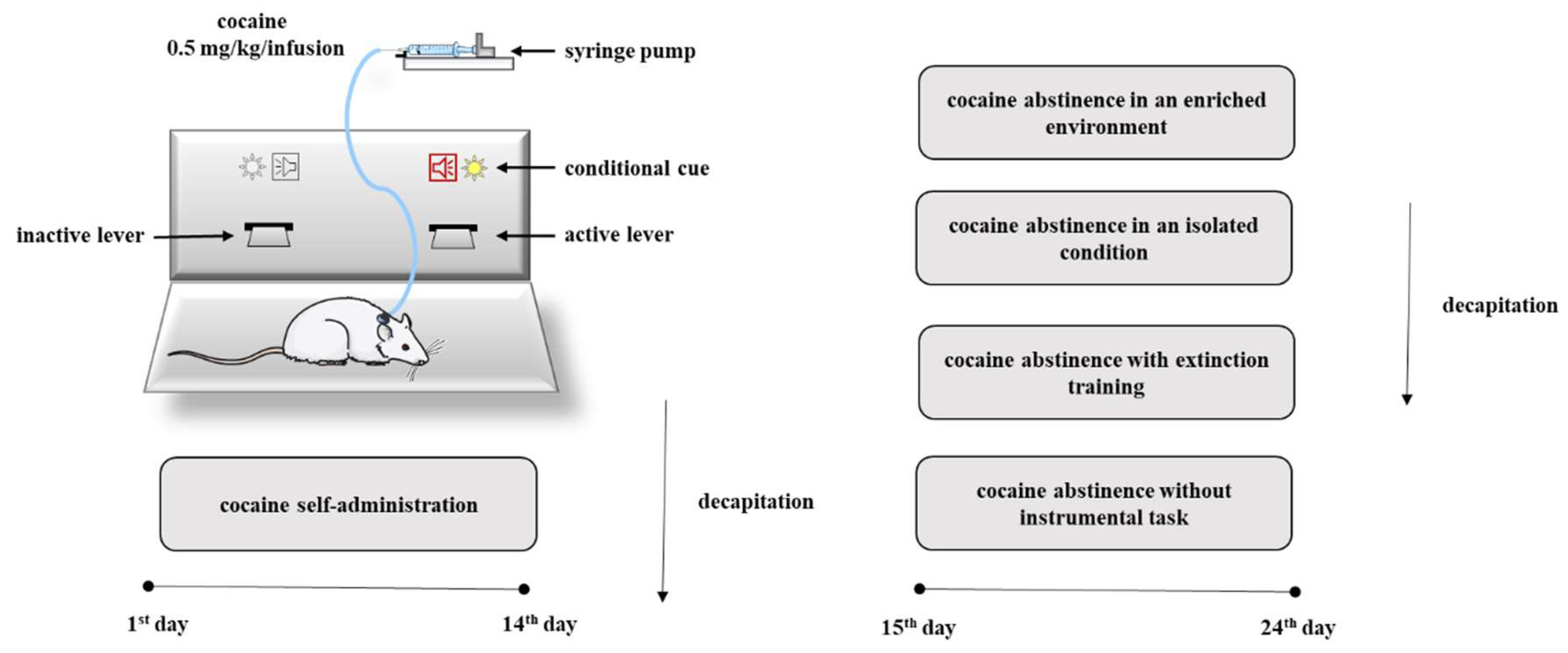
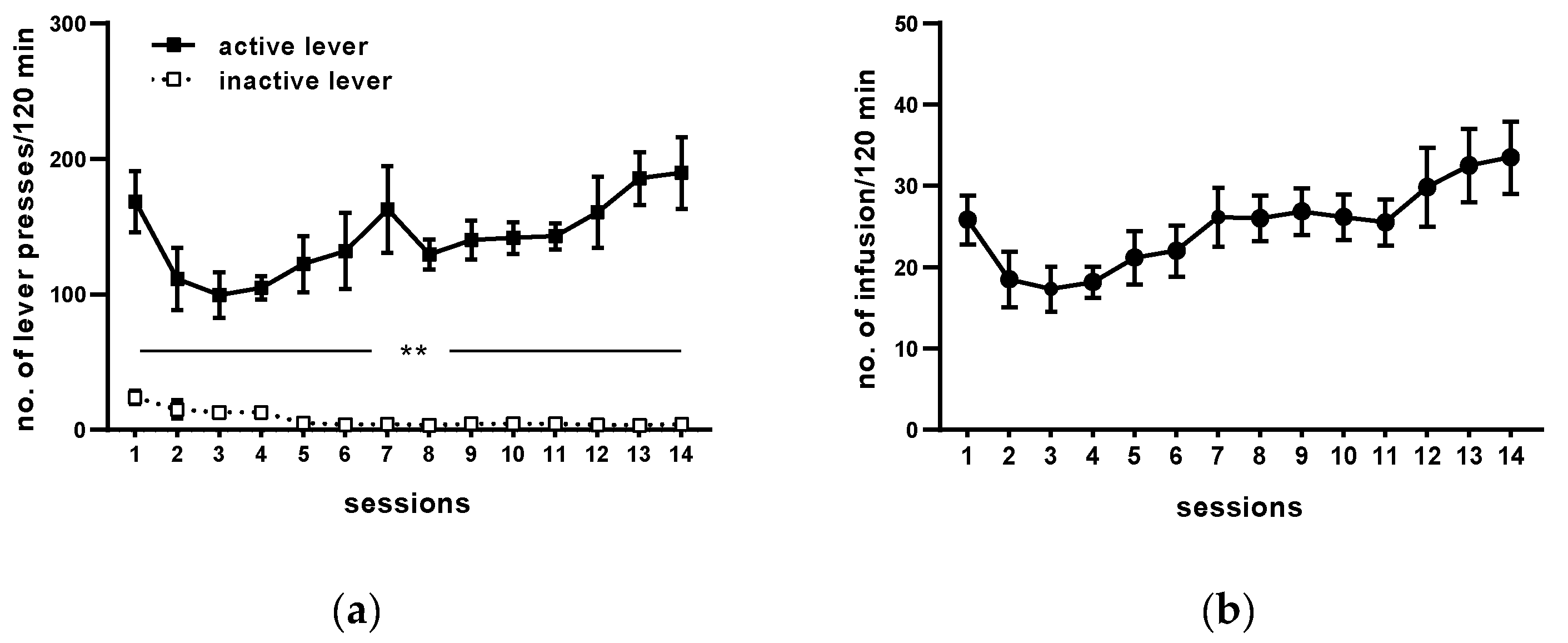
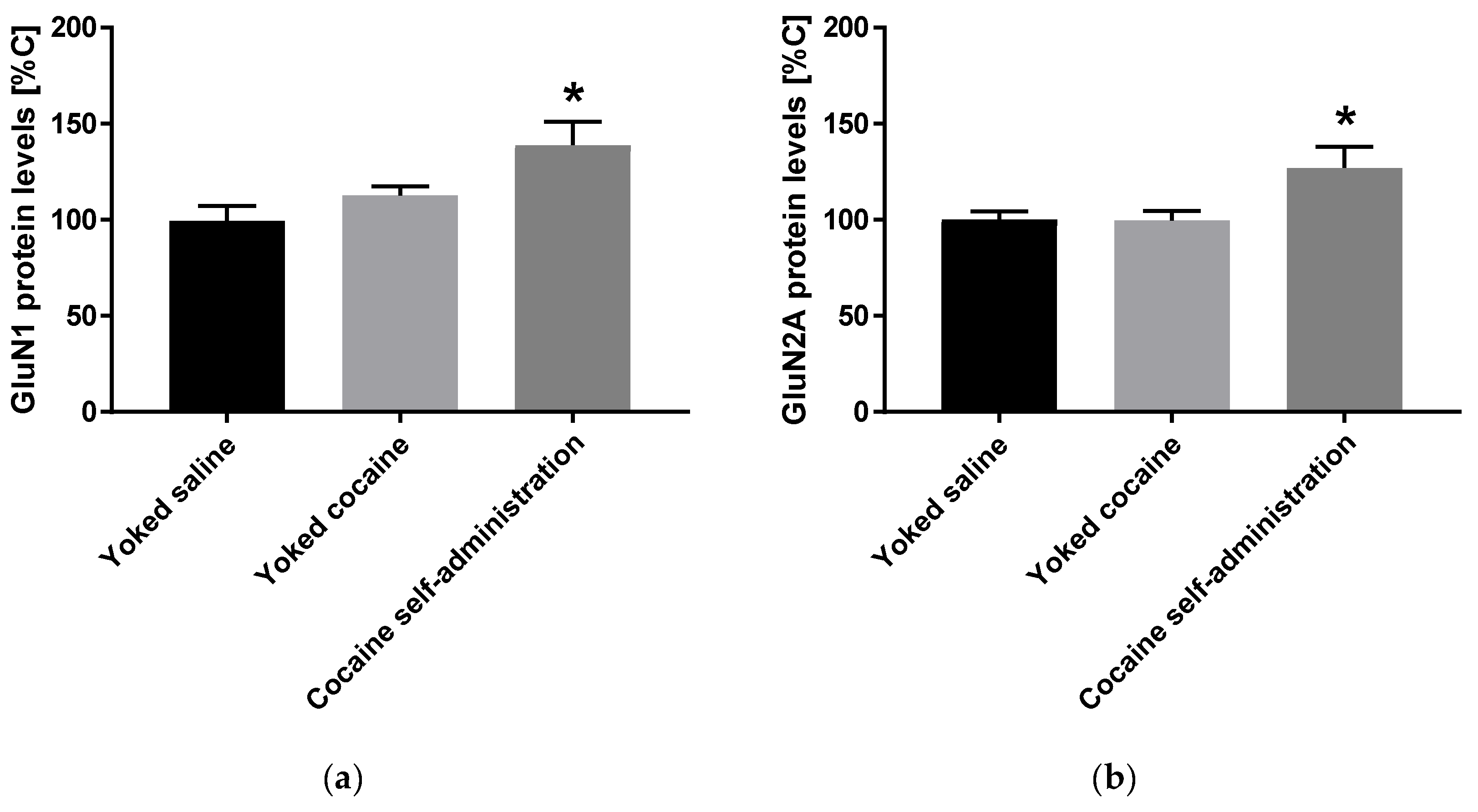
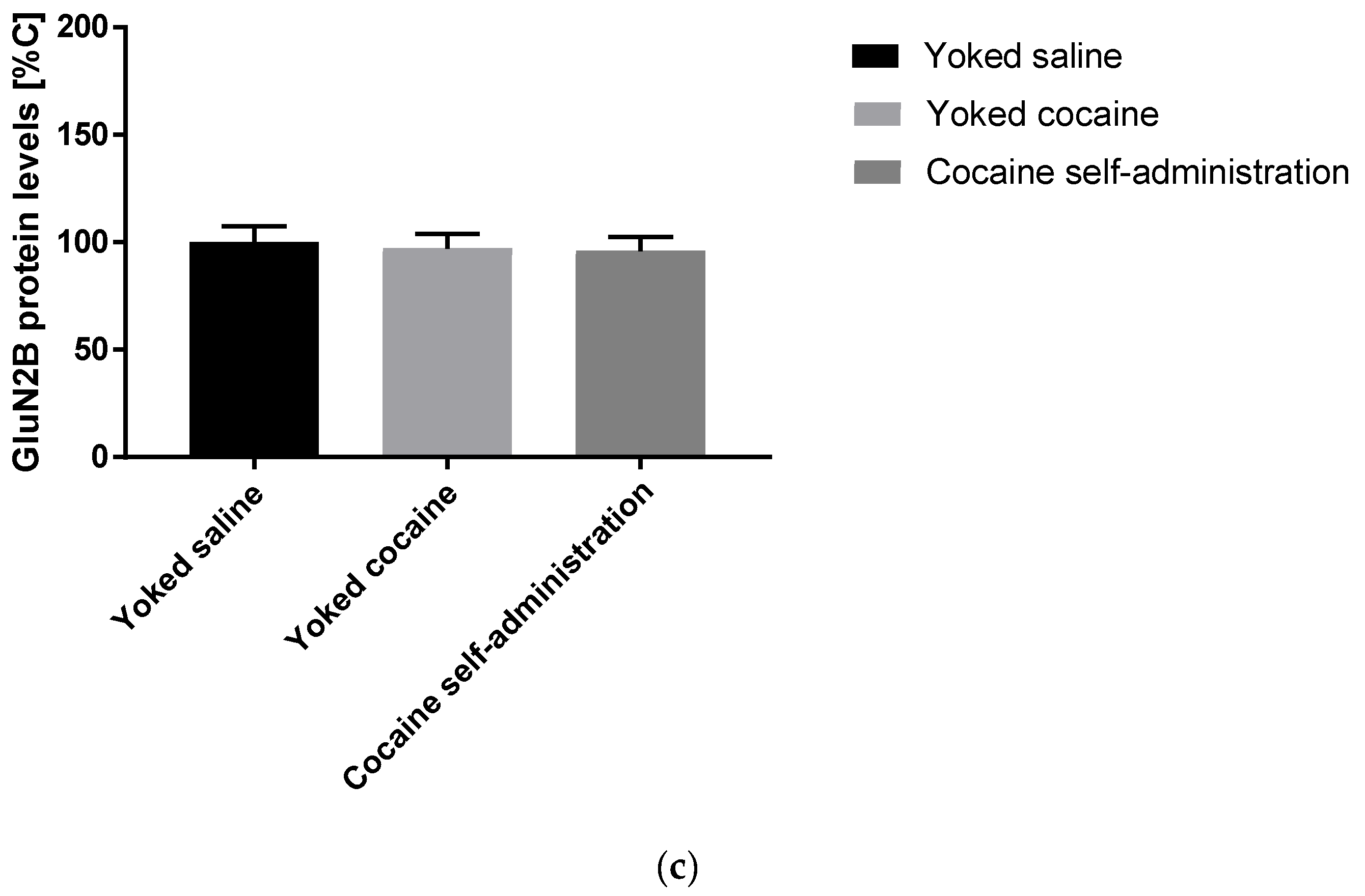
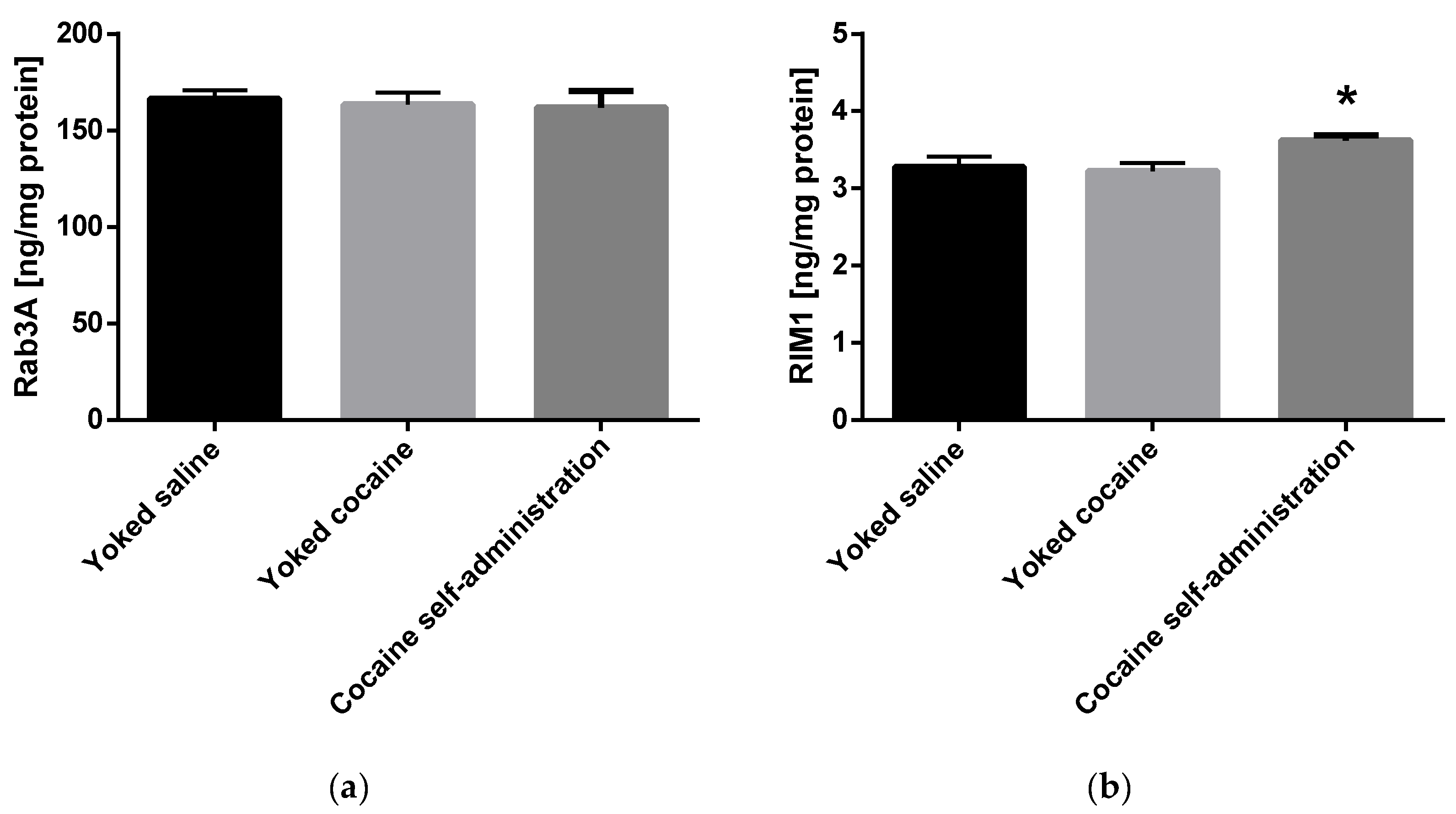
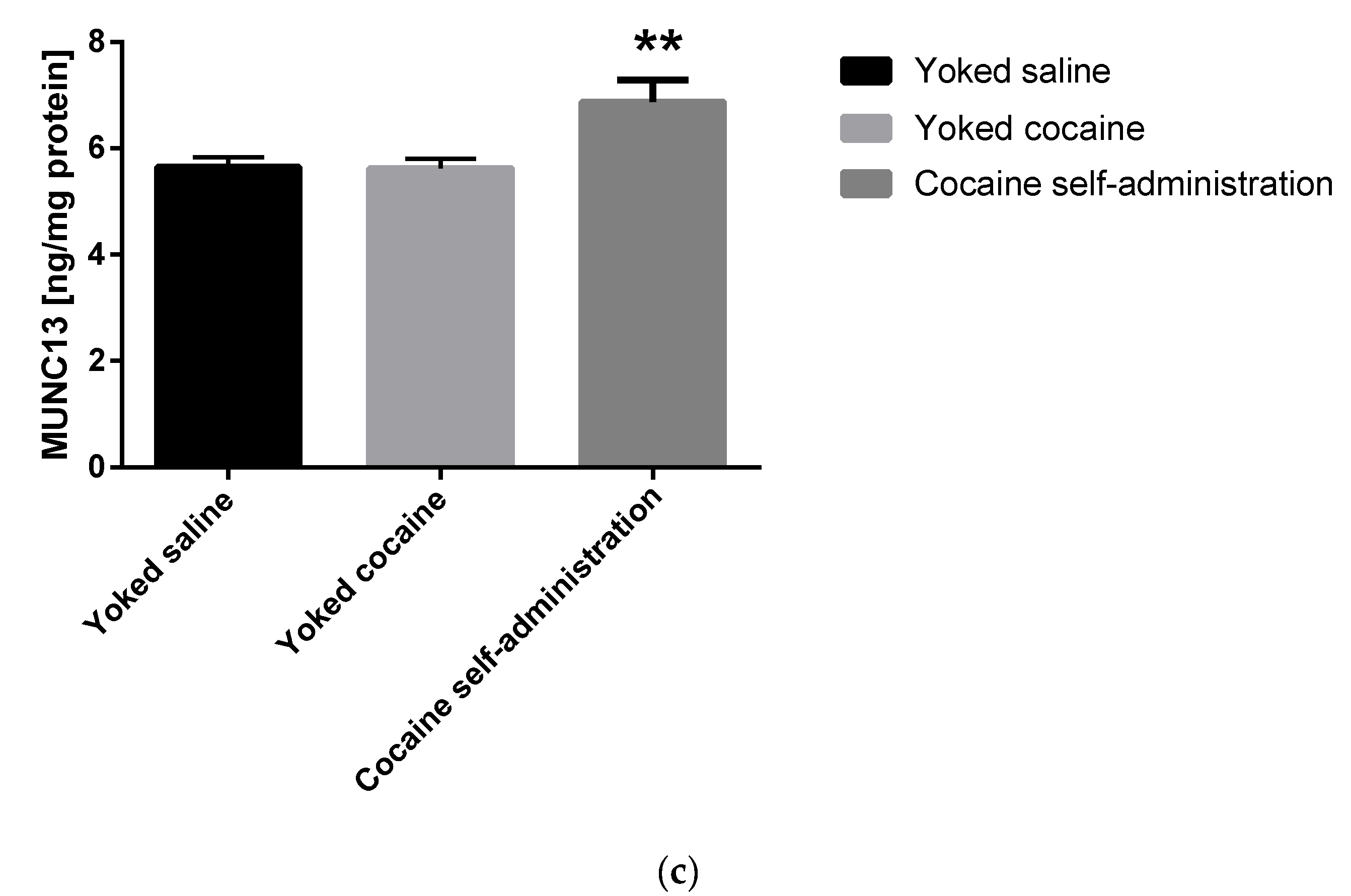
| Number of | Active Lever | Inactive Lever | Infusion |
|---|---|---|---|
| Future cocaine abstinence in an enriched environment | |||
| Cocaine self-administration | 197 ± 16.50 | 4 ± 0.57 | 28 ± 1.02 |
| Yoked cocaine | 10 ± 1.56 | 8 ± 0.79 | |
| Yoked saline | 12 ± 1.11 | 8 ± 0.32 | |
| Future cocaine abstinence in an isolated condition | |||
| Cocaine self-administration | 203 ± 9.81 | 9 ± 5.13 | 29 ± 0.42 |
| Yoked cocaine | 38 ± 13.80 | 17 ± 5.34 | |
| Yoked saline | 18 ± 2.93 | 8 ± 0.72 | |
| Future cocaine abstinence with extinction training | |||
| Cocaine self-administration | 145 ± 4.00 | 8 ± 2.39 | 26 ± 1.00 |
| Yoked cocaine | 2 ± 0.59 | 3 ± 0.42 | |
| Yoked saline | 5 ± 0.66 | 4 ± 0.65 | |
| Future cocaine abstinence without instrumental task | |||
| Cocaine self-administration | 163 ± 4.68 | 11 ± 2.07 | 23 ± 1.31 |
| Yoked cocaine | 14 ± 5.46 | 7 ± 2.37 | |
| Yoked saline | 5 ±0.48 | 4 ± 0.44 | |
| NMDA Receptor Subunits | Yoked Saline | Yoked Cocaine | Cocaine Self-Administration | Statistical Analyses |
|---|---|---|---|---|
| Cocaine abstinence in an enriched environment | ||||
| GluN1 | 100 ± 10.9 | 92.2 ± 9.5 | 110.8 ± 11.0 | F(2, 21) = 0.779; p = 0.472 |
| GluN2A | 100 ± 5.8 | 100.9 ± 7.3 | 92.8 ± 6.1 | F(2, 21) = 0.476; p = 0.628 |
| GluN2B | 100 ± 8.0 | 91.8 ± 11.3 | 102.0 ± 15.9 | F(2, 21) = 0.197; p = 0.822 |
| Cocaine abstinence in an isolated condition | ||||
| GluN1 | 100 ± 14.1 | 92.0 ± 4.8 | 92.2 ± 14.9 | F(2, 18) = 0.141; p = 0.869 |
| GluN2A | 100 ± 4.7 | 91.2 ± 10.6 | 97.6 ± 11.4 | F(2, 18) = 0.235; p = 0.793 |
| GluN2B | 100 ± 3.5 | 94.4 ± 7.5 | 99.7 ± 6.5 | F(2, 18) = 0.271; p = 0.766 |
| Cocaine abstinence with extinction training | ||||
| GluN1 | 100 ± 3.2 | 129.3 ± 13.2 | 144.2 ± 15.6 * | F(2, 21) = 3.555; p = 0.047 |
| GluN2A | 100 ± 4.7 | 114.9 ± 10.9 | 129.1 ± 11.9 | F(2, 21) = 2.234; p = 0.132 |
| GluN2B | 100 ± 5.2 | 108.5 ± 8.5 | 106.0 ± 10.6 | F(2, 21) = 0.273; p = 0.764 |
| Cocaine abstinence without instrumental task | ||||
| GluN1 | 100 ± 12.6 | 104.5 ± 21.8 | 101.9 ± 17.8 | F(2, 21) = 0.016; p = 0.984 |
| GluN2A | 100 ± 6.7 | 113.2 ± 13 | 103.6 ± 10.7 | F(2, 21) = 0.424; p = 0.660 |
| GluN2B | 100 ± 11.3 | 102.6 ± 14.2 | 106.1 ± 11.8 | F(2, 21) = 0.061; p = 0.942 |
| Protein | Yoked Saline [ng/mg Protein] | Yoked Cocaine [ng/mg Protein] | Cocaine Self-Administration [ng/mg Protein] | Statistical Analyses |
|---|---|---|---|---|
| Cocaine abstinence in an enriched environment | ||||
| Rab3a | 147.8 ± 5.4 | 135.4 ± 2.7 | 136.5 ± 4.7 | F(2, 21) = 2.401; p = 0.115 |
| RIM1 | 3.7 ± 0.2 | 3.4 ± 0.1 | 3.6 ± 0.2 | F(2, 21) = 0.926; p = 0.412 |
| Munc13 | 5.4 ± 0.1 | 5.3 ± 0.1 | 5.9 ± 0.3 * | F(2, 21) = 3.807; p = 0.039 |
| Cocaine abstinence in an isolated condition | ||||
| Rab3a | 143 ± 4.4 | 131.5 ± 3.2 | 137.9 ± 2.1 | F(2, 18) = 2.869; p = 0.083 |
| RIM1 | 4.2 ± 0.2 | 4.5 ± 0.2 | 4.3 ± 0.2 | F(2, 18) = 1.049; p = 0.371 |
| Munc13 | 6.1 ± 0.3 | 6.6 ± 0.2 | 6.6 ± 0.3 | F(2, 18) = 0.446; p = 0.647 |
| Cocaine abstinence with extinction training | ||||
| Rab3a | 132 ± 5.1 | 137.1 ± 3.4 | 128.9 ± 3 | F(2, 21) = 1.109; p = 0.349 |
| RIM1 | 4.2 ± 0.2 | 4.6 ± 0.1 | 4.2 ± 0.1 | F(2, 21) = 1.437; p = 0.26 |
| Munc13 | 5.8 ± 0.2 | 6.3 ± 0.1 | 5.6 ± 0.2 | F(2, 21) = 3.448; p = 0.051 |
| Cocaine abstinence without instrumental task | ||||
| Rab3a | 138.0 ± 3.8 | 130.9 ± 5.3 | 141.7 ± 4.4 | F(2, 21) = 1.449; p = 0.257 |
| RIM1 | 3.9 ± 0.1 | 3.8 ± 0.1 | 4.2 ± 0.2 | F(2, 21) = 2.307; p = 0.124 |
| Munc13 | 5.9 ± 0.4 | 5.6 ± 0.1 | 5.7 ± 0.2 | F(2, 21) = 0.461; p = 0.636 |
© 2020 by the authors. Licensee MDPI, Basel, Switzerland. This article is an open access article distributed under the terms and conditions of the Creative Commons Attribution (CC BY) license (http://creativecommons.org/licenses/by/4.0/).
Share and Cite
Smaga, I.; Wydra, K.; Frankowska, M.; Fumagalli, F.; Sanak, M.; Filip, M. Cocaine Self-Administration and Abstinence Modulate NMDA Receptor Subunits and Active Zone Proteins in the Rat Nucleus Accumbens. Molecules 2020, 25, 3480. https://doi.org/10.3390/molecules25153480
Smaga I, Wydra K, Frankowska M, Fumagalli F, Sanak M, Filip M. Cocaine Self-Administration and Abstinence Modulate NMDA Receptor Subunits and Active Zone Proteins in the Rat Nucleus Accumbens. Molecules. 2020; 25(15):3480. https://doi.org/10.3390/molecules25153480
Chicago/Turabian StyleSmaga, Irena, Karolina Wydra, Małgorzata Frankowska, Fabio Fumagalli, Marek Sanak, and Małgorzata Filip. 2020. "Cocaine Self-Administration and Abstinence Modulate NMDA Receptor Subunits and Active Zone Proteins in the Rat Nucleus Accumbens" Molecules 25, no. 15: 3480. https://doi.org/10.3390/molecules25153480
APA StyleSmaga, I., Wydra, K., Frankowska, M., Fumagalli, F., Sanak, M., & Filip, M. (2020). Cocaine Self-Administration and Abstinence Modulate NMDA Receptor Subunits and Active Zone Proteins in the Rat Nucleus Accumbens. Molecules, 25(15), 3480. https://doi.org/10.3390/molecules25153480






